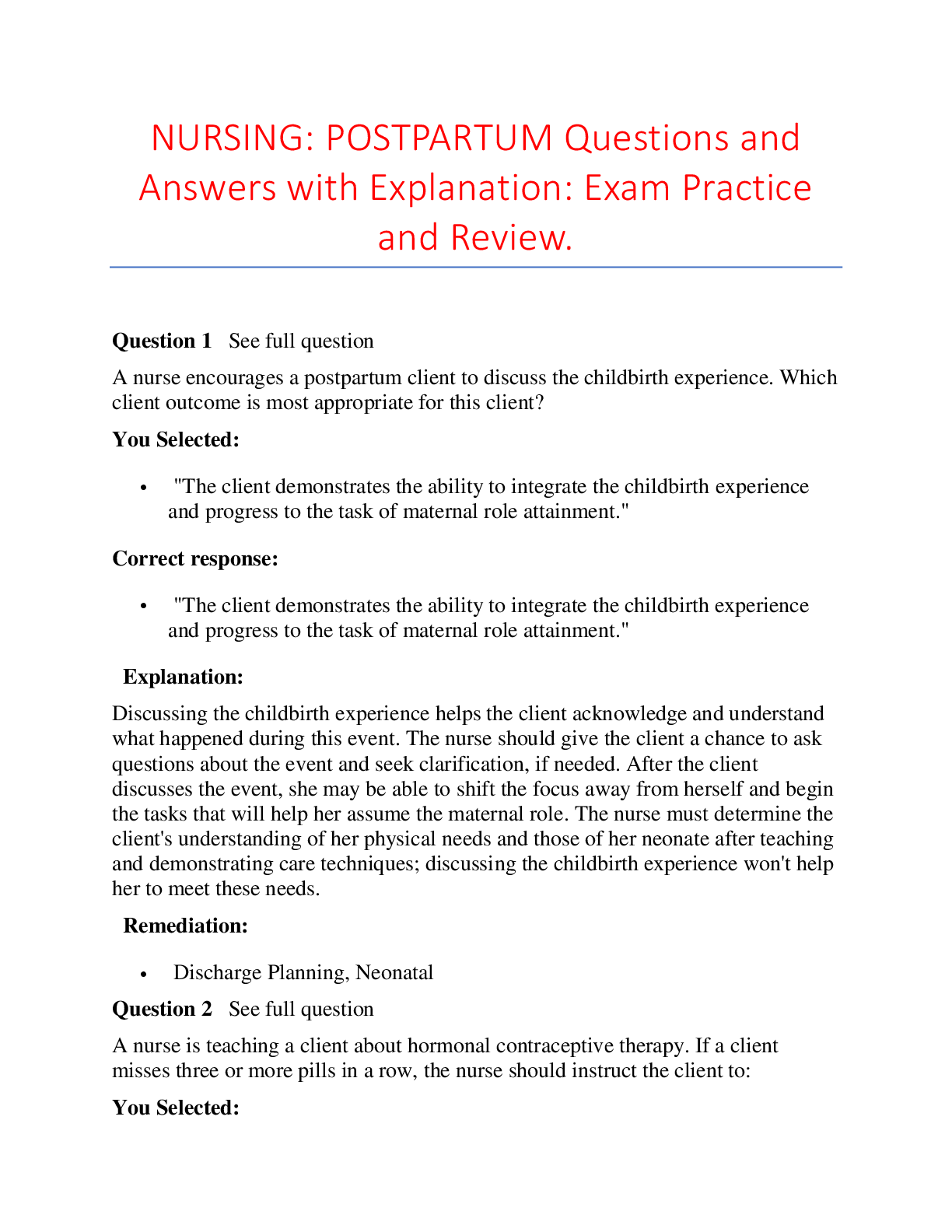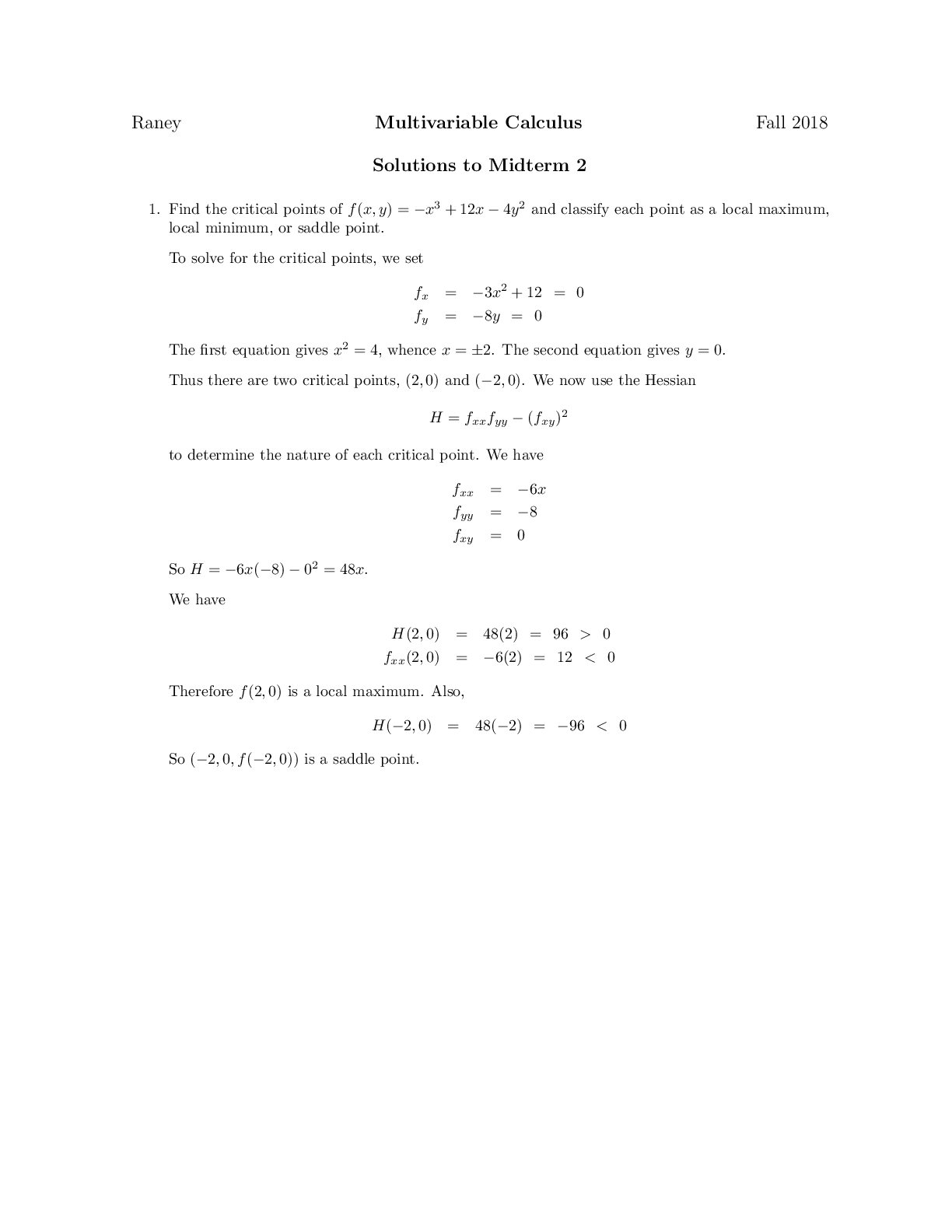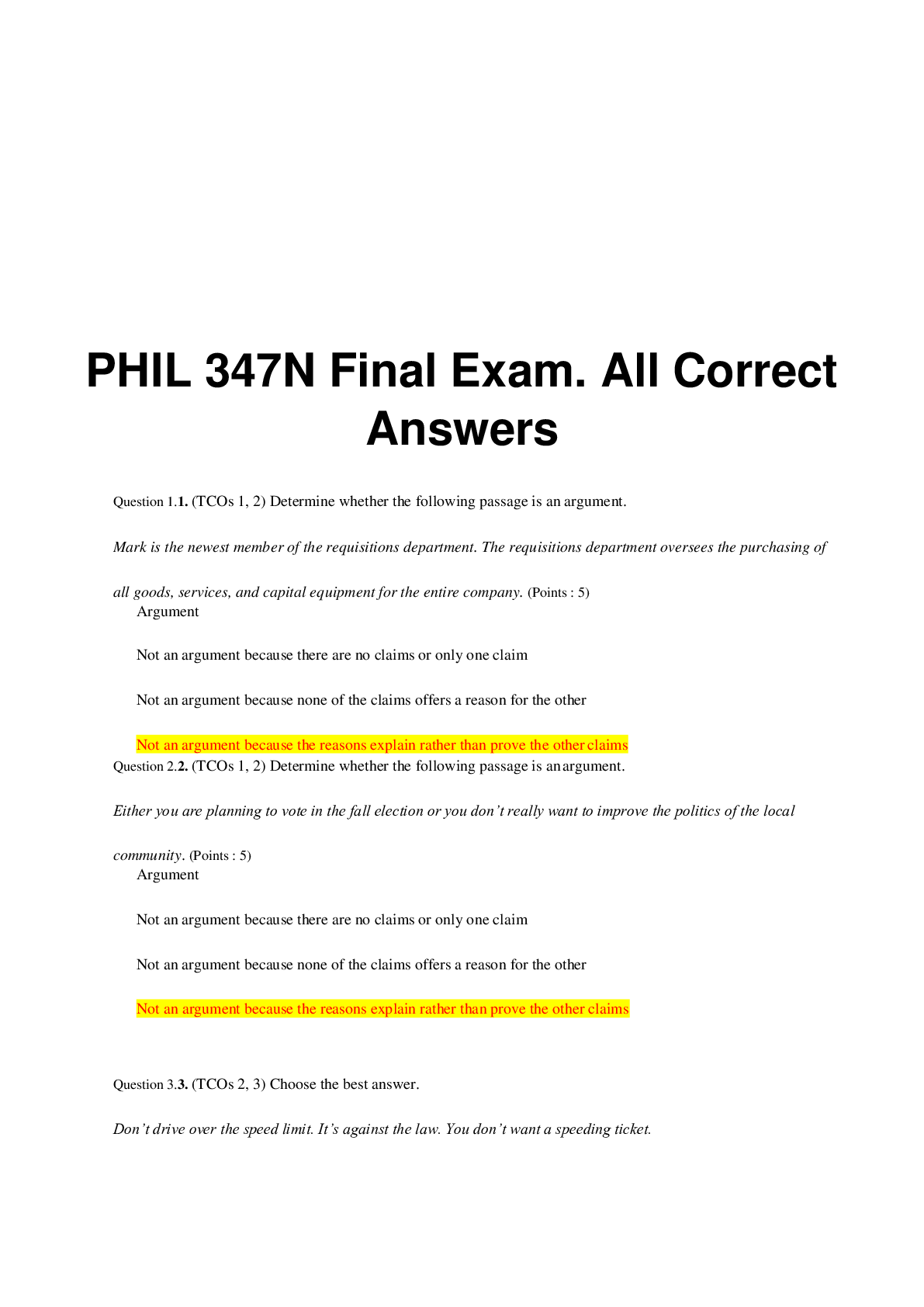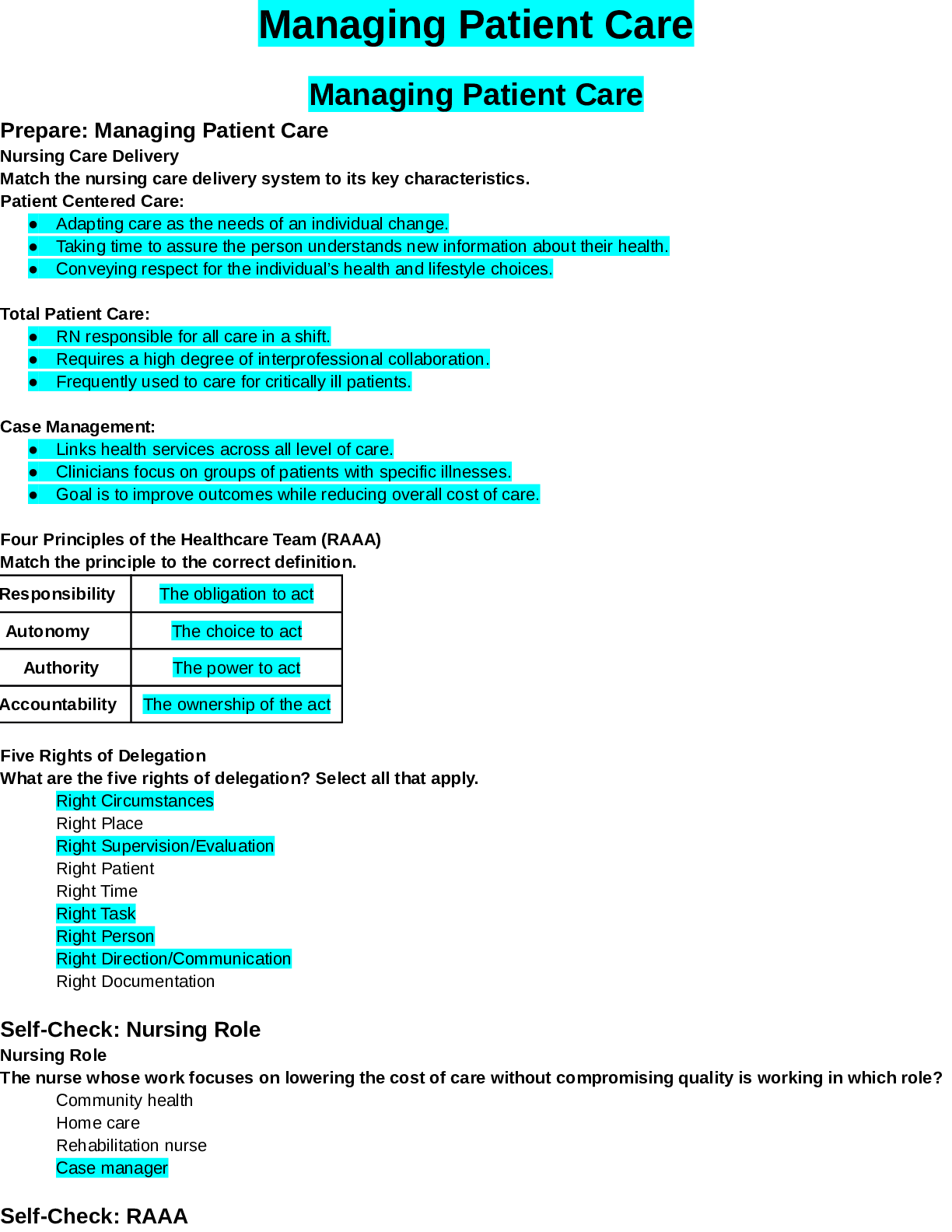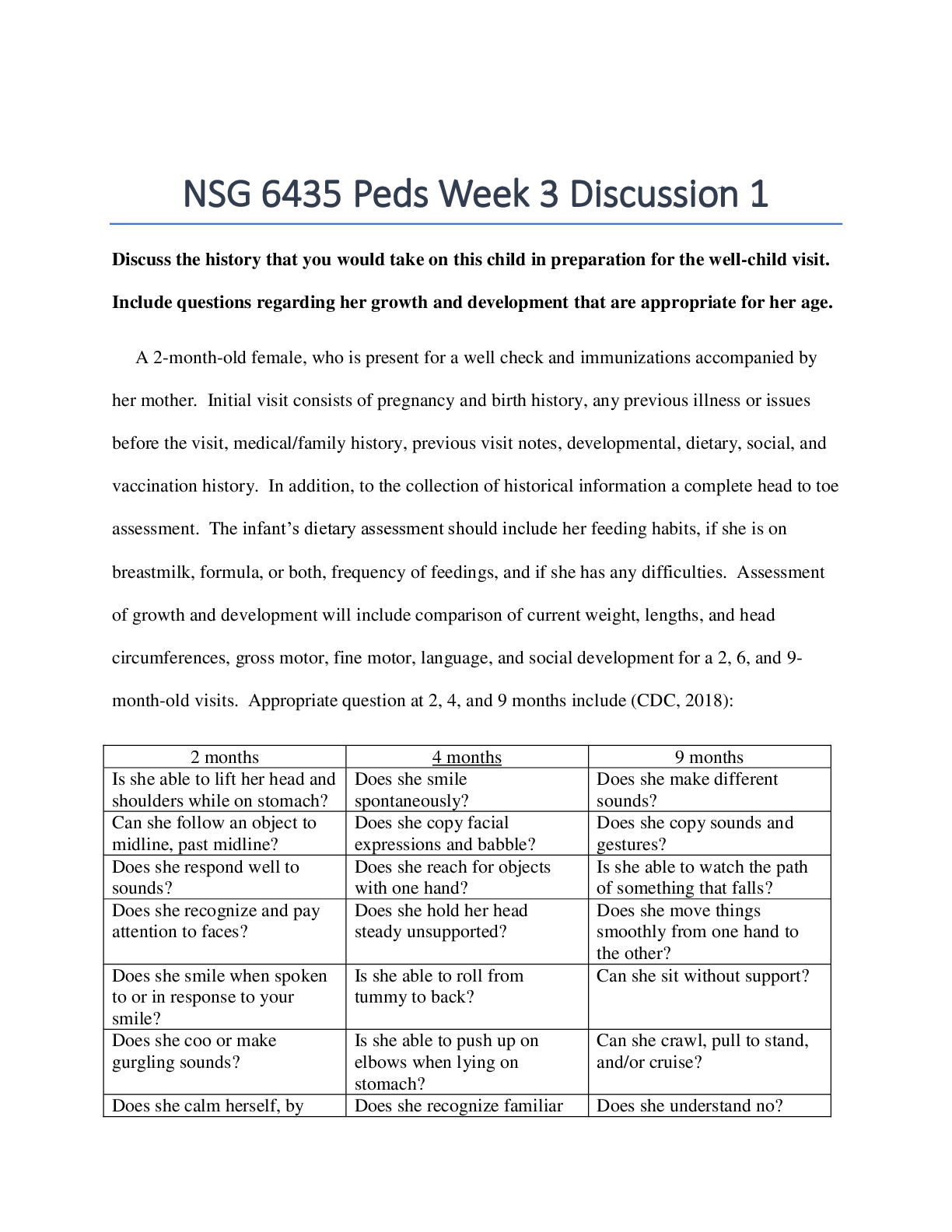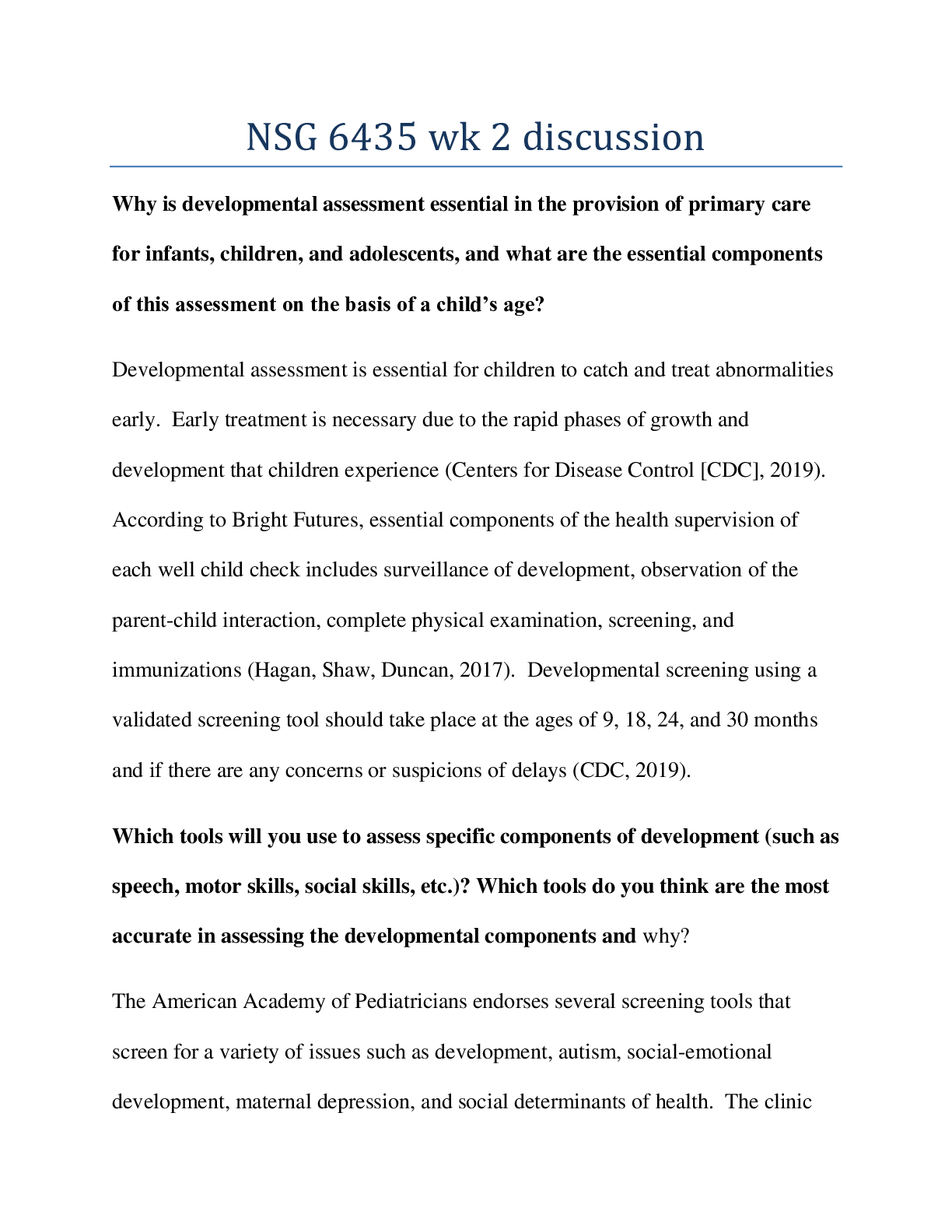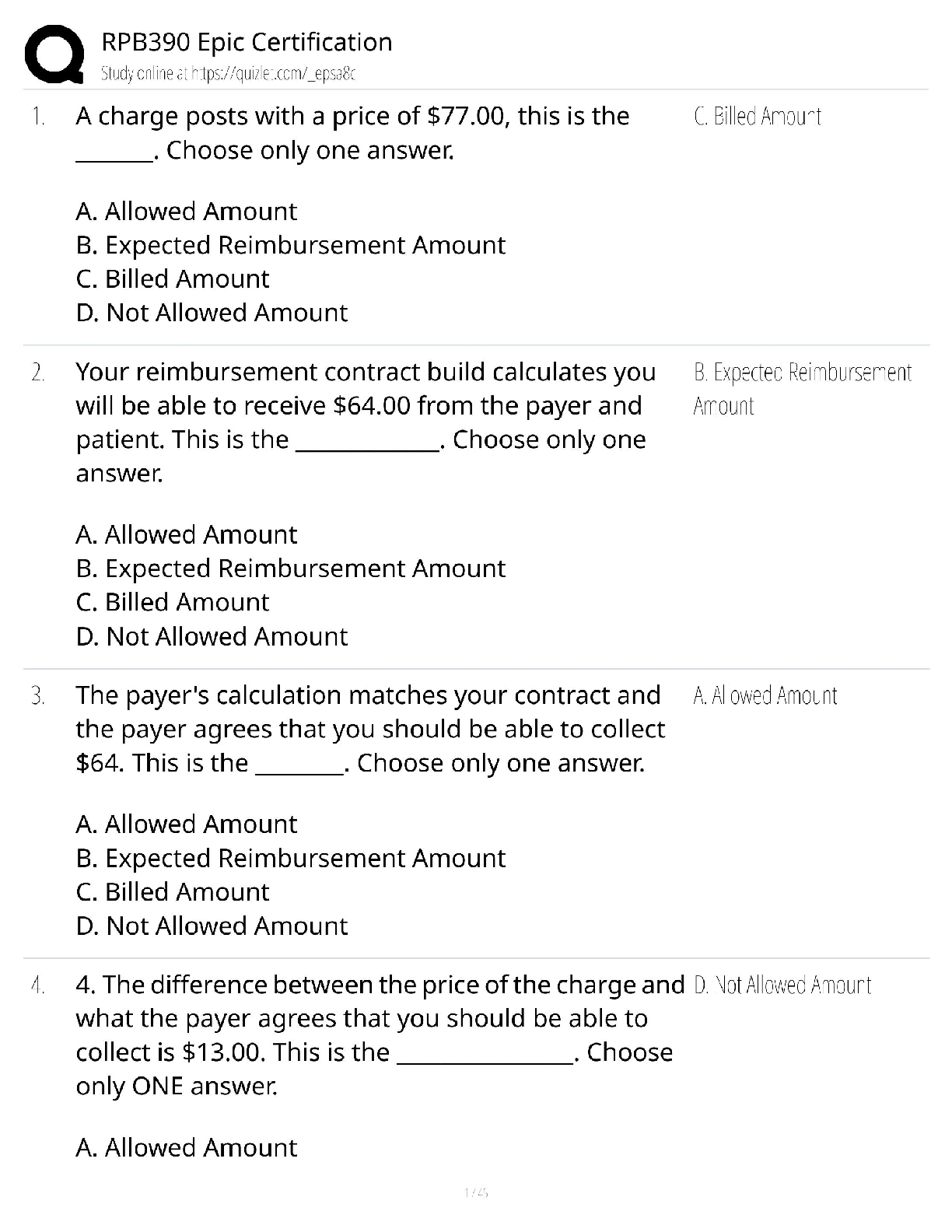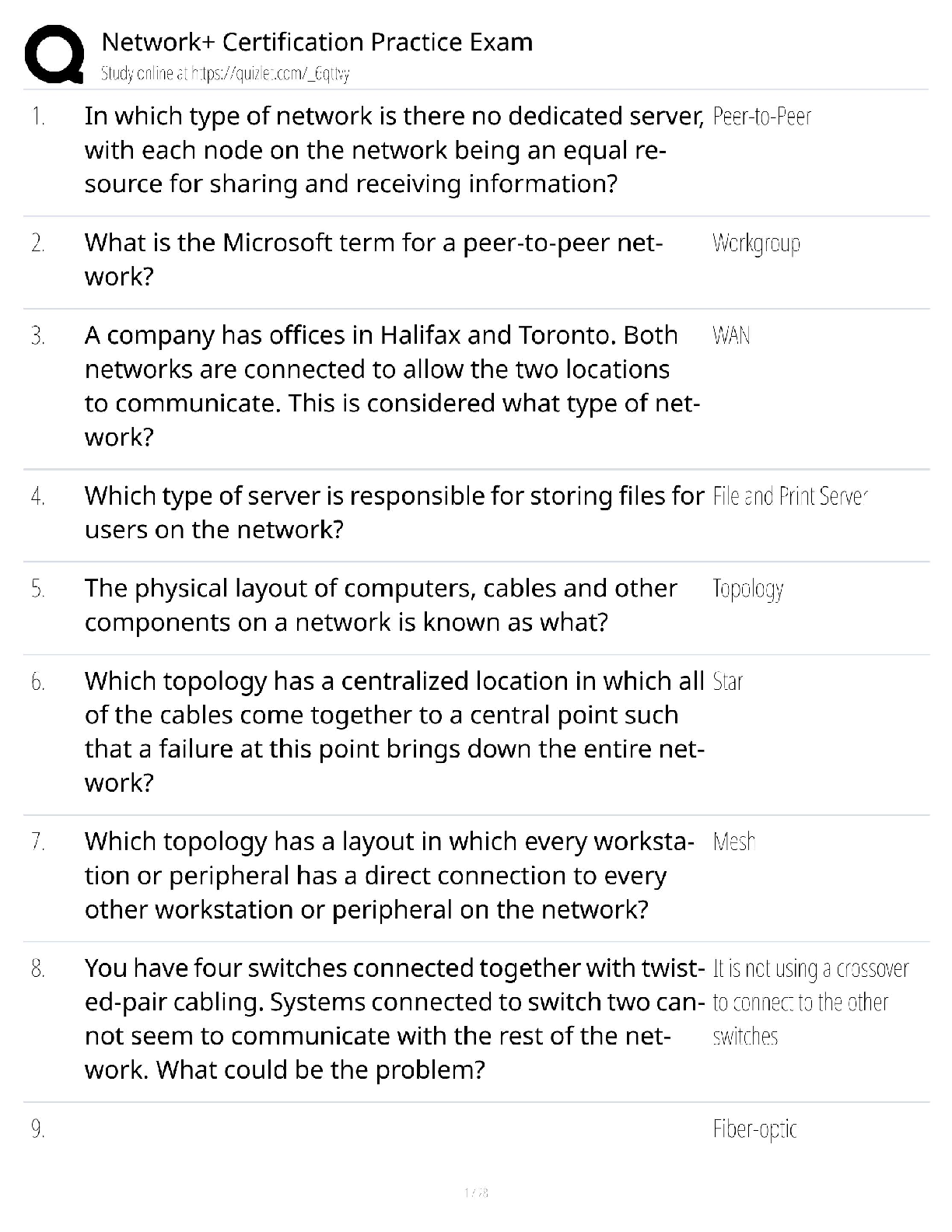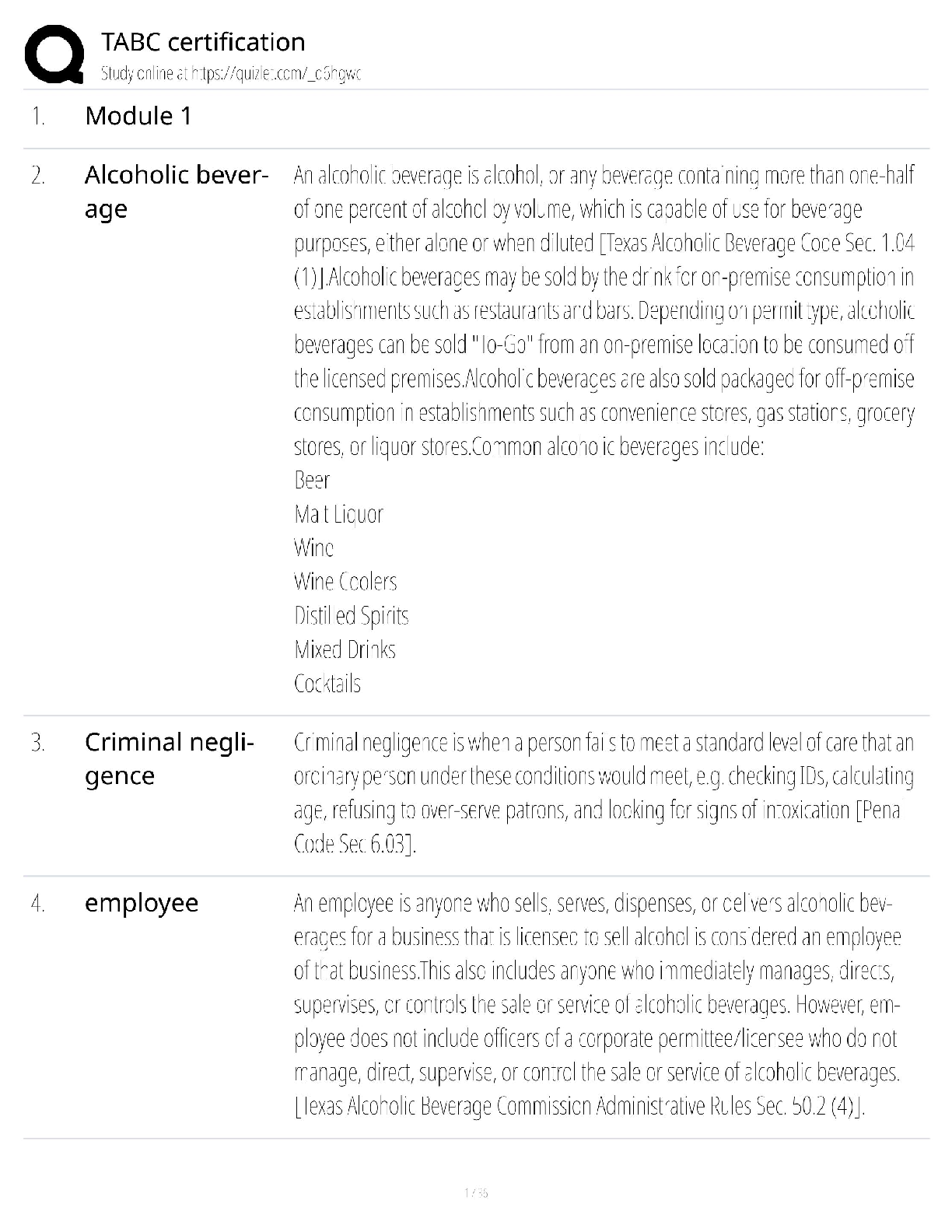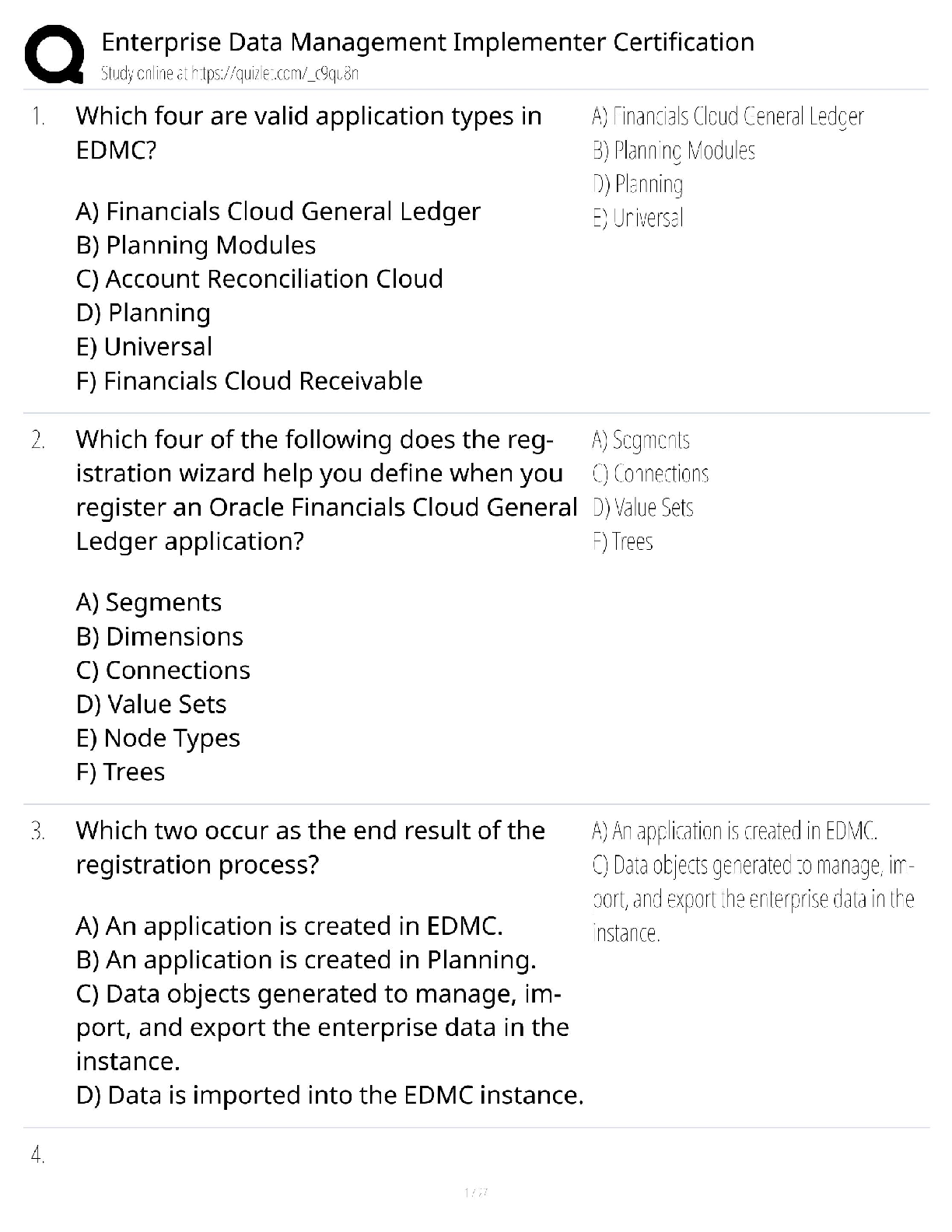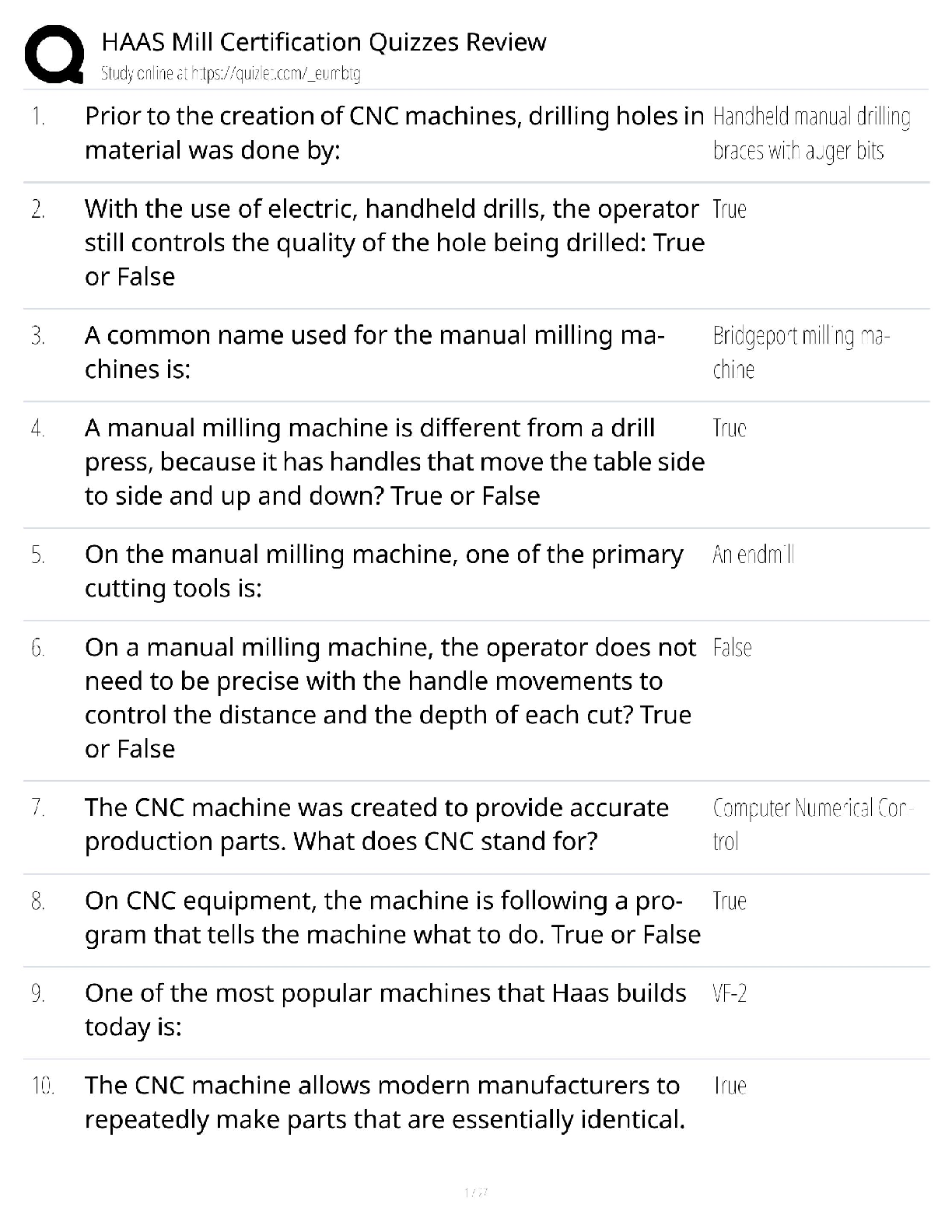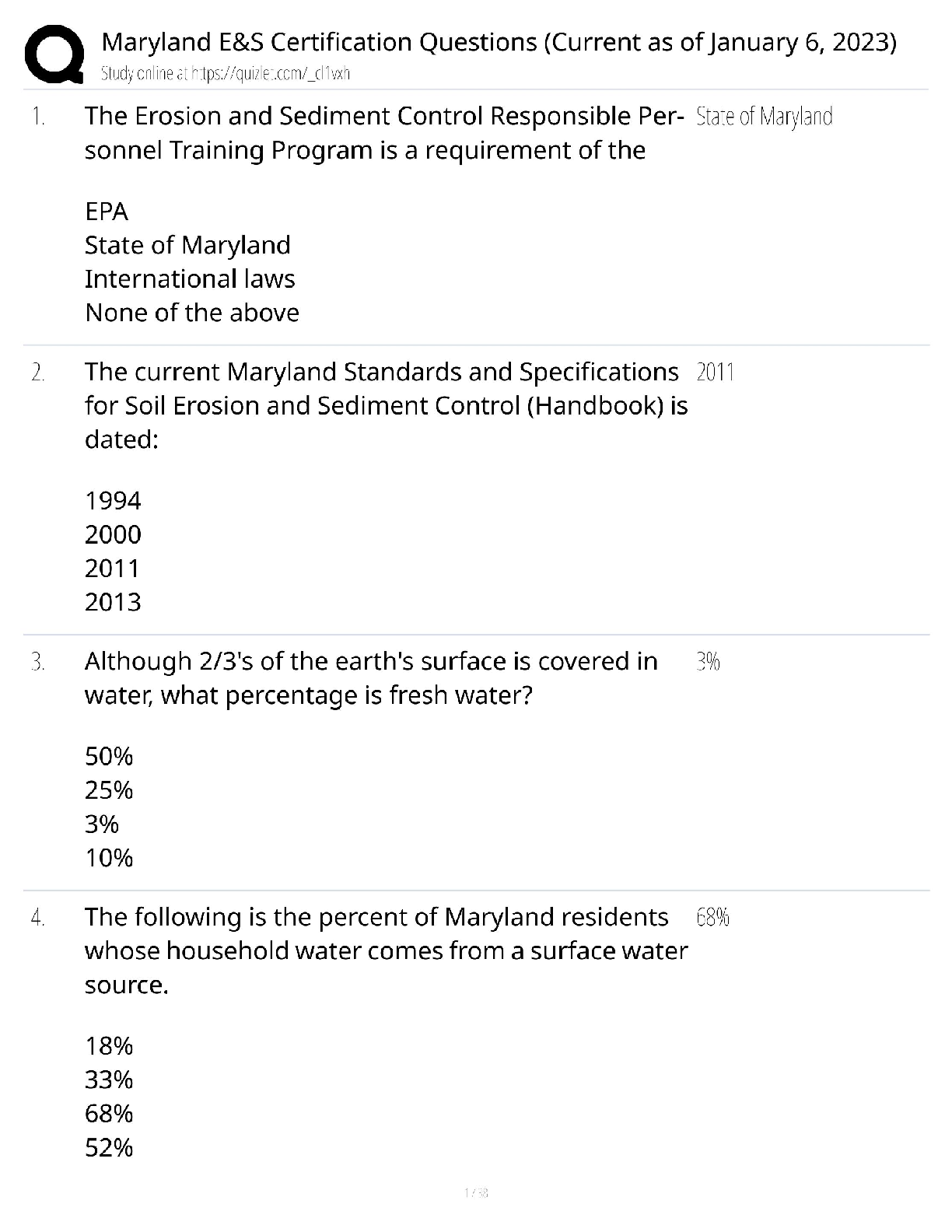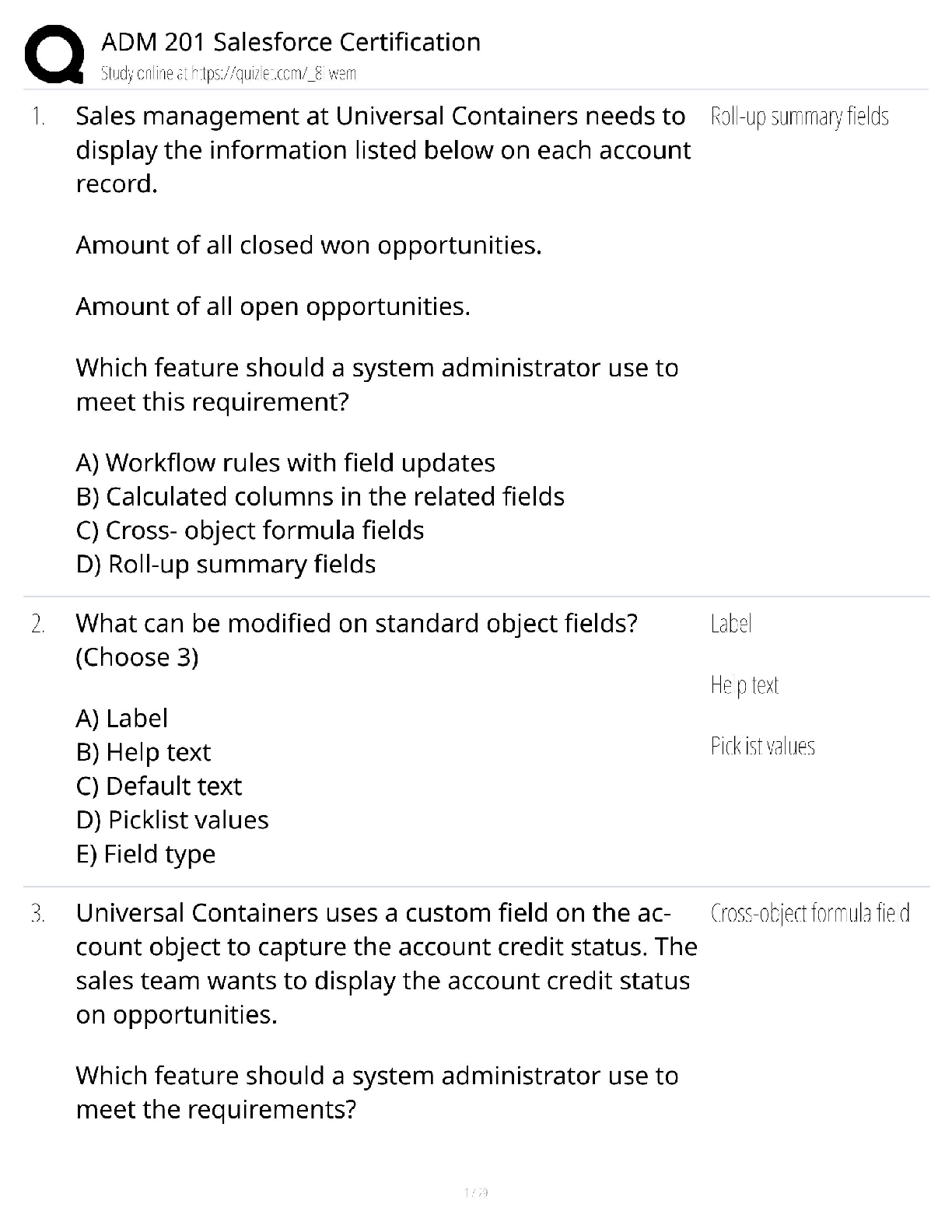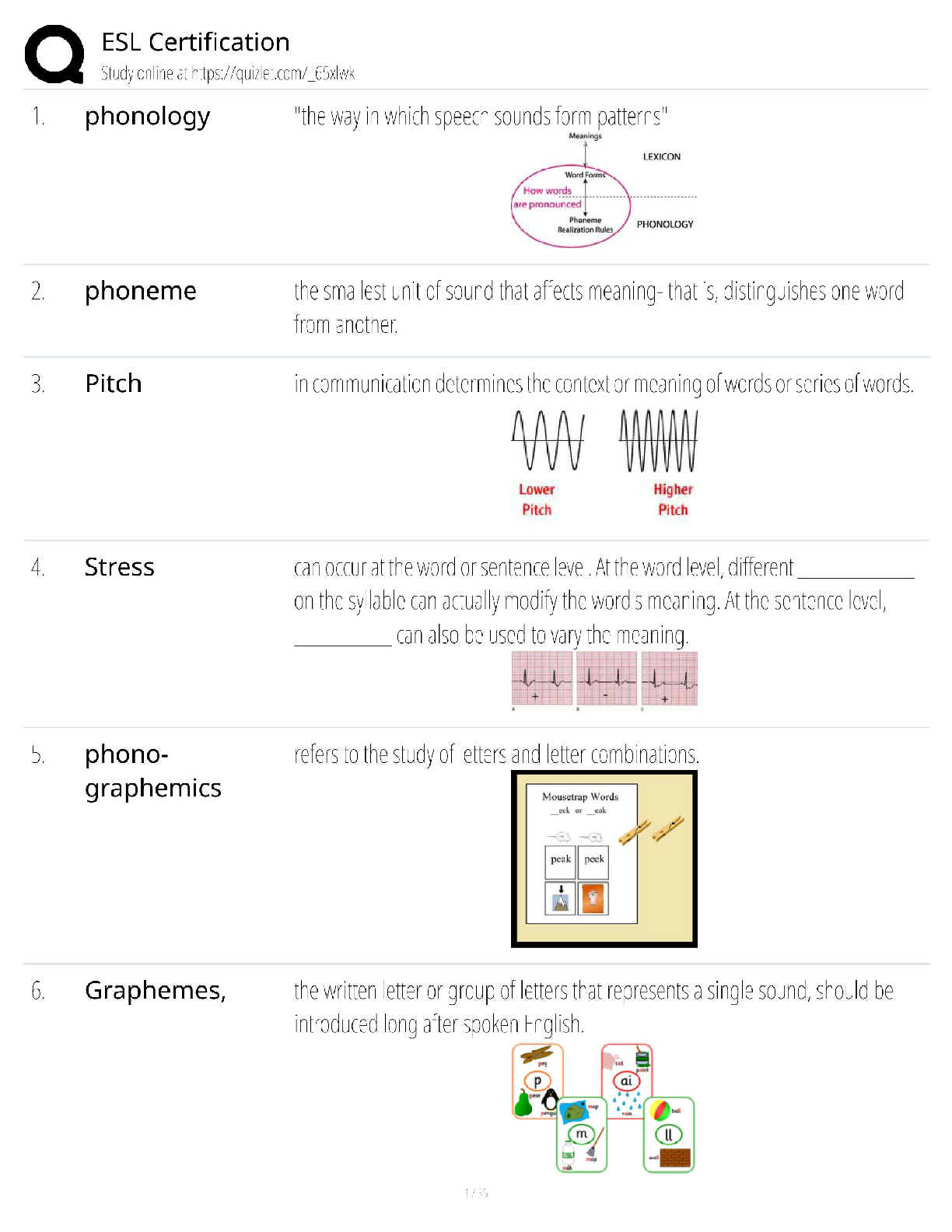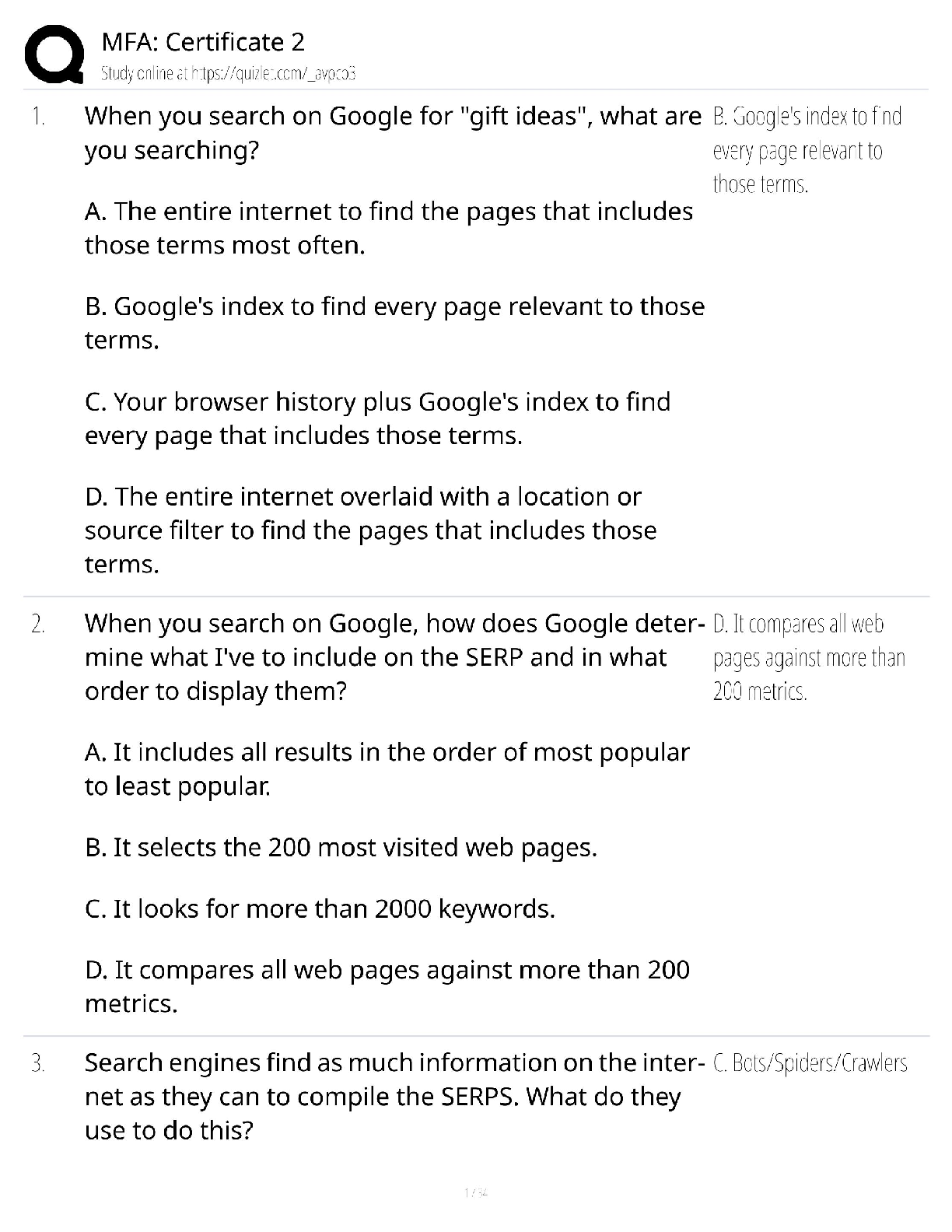*NURSING > QUESTIONS & ANSWERS > PATHOPHYSIOLOGY QUESTIONS AND ANSWERS. With Explanations and Answering Tips (All)
PATHOPHYSIOLOGY QUESTIONS AND ANSWERS. With Explanations and Answering Tips
Document Content and Description Below
PATHOPHYSIOLOGY QUESTIONS AND ANSWERS Which complication does the nurse monitor for in a client with hyperventilation? Hypercapnia Respiratory alkalosis 3 Excessive productive coughing 4 Increa ... sed carbon dioxide in arterial blood 75%of students nationwide answered this question correctly. View Topics 3. 3681205319 Confidence: Nailed it Stats Issue with this question? 3.The nurse assesses a client during an acute asthma episode. Which clinical manifestation will the nurse expect to observe? Select all that apply. Coughing 2 Bradycardia Expiratory wheezing 4 Foul-smelling sputum Use of accessory breathing muscles 60%of students nationwide answered this question correctly. View Topics 4. 3681206743 Confidence: Just a guess Stats Issue with this question? 4. A nurse assesses a client who has been admitted to the emergency department with a diagnosis of primary spontaneous pneumothorax. Which characteristics would the nurse expect? Select all that apply. Recent chest trauma Occurs unexpectedly 3 Peak age is 50 to 60 years old Symptoms may develop during sleep 35%of students nationwide answered this question correctly. View Topics 7. 3681208034 Confidence: Nailed it Stats Issue with this question? 7. What are the possible causes for the development of hypercapnia in a client who has a Paco2 level of 62 mm Hg? Select all that apply. Emphysema Sleep apnea Myasthenia gravis Muscular dystrophy 5 Increased drive to breathe 19%of students nationwide answered this question correctly. View Topics 8. 3681203878 Confidence: Nailed it Stats Issue with this question? 8. A nurse finds the condition pictured (see diagram) upon assessment of a client. What mechanism would cause the changes seen in this finger? Chronic hypoxemia 2 Chronic hypocapnia Chronic hypercapnia 4 Chronic hyperventilation 78%of students nationwide answered this question correctly. View Topics 9. 3681205387 Confidence: Just a guess Stats Issue with this question? 9. A client has a Paco2 of 30 mm Hg. Which term will the nurse use to describe this condition when giving report to the oncoming shift? Cyanosis 2 Orthopnea Hypocapnia 4 Hypoventilation 76%of students nationwide answered this question correctly. View Topics 11. 3681206779 Confidence: Just a guess Stats Issue with this question? 11. Which information indicates the nurse has an accurate understanding about the major role of neutrophils in acute respiratory distress syndrome (ARDS)? 1 They phagocytize pathogens. 2 They phagocytize alveolar macrophages. They release α1-antitrypsin that degrades alveolar septa. They release inflammatory mediators that damage alveolar-capillary membranes. 57%of students nationwide answered this question correctly. View Topics 12. 3681205362 Confidence: Just a guess Stats Issue with this question? 12. Which clients should the nurse assess for hypocapnia? Select all that apply. 1 One that is hypoventilating One that has severe anxiety One with respiratory alkalosis One with an acute head injury One that has a depressed respiratory center Hypocapnia can occur with severe anxiety, acute head injury, and pain. Hypocapnia causes respiratory alkalosis. Hypoventilation and a depressed respiratory center would cause hypercapnia. 1. Which finding would alert the nurse that a client has a confirmed case of active tuberculosis? 1 Pink, frothy sputum 2 Positive tuberculin skin test Positive sputum culture for acid-fast bacillus 4 Presentation of typical symptoms including weight gain 54%of students nationwide answered this question correctly. View Topics 5. 3681203872 Confidence: Nailed it Stats Issue with this question? 5. Which position should the nurse recommend to decrease orthopnea in a client with chronic obstructive pulmonary disease (COPD)? 1 Prone 2 Supine 3 Recumbent Forward leaning Which clinical manifestations will the nurse typically find in a client with an infected parietal pleura? 1 Hematemesis and eupnea 2 Bloody sputum and clubbing 3 Enlarged finger tips and cyanosis Stabbing pain and pleural friction rub 75%of students nationwide answered this question correctly. View Topics 3. 3681206729 Confidence: Nailed it Stats Issue with this question? 3. Which interventions will help prevent atelectasis postoperatively? Select all that apply. 1 Extended bed rest Deep-breathing exercises Frequent position changes Incentive spirometer usage 5 Administration of antibiotics 63%of students nationwide answered this question correctly. View Topics 5. 3681205395 Confidence: Nailed it Stats Issue with this question? 5. A nurse plans interventions based on the primary cause of airway obstruction (air trapping) in a client with chronic bronchitis. The interventions will focus on which primary cause? 1 Infection Mucus plugs 3 Hyperventilation 4 Thinning bronchial smooth muscle 64%of students nationwide answered this question correctly. View Topics 7. 3681208024 Confidence: Nailed it Stats Issue with this question? 7. A nurse monitors a client with bacterial pneumonia for hypoxemia. What is the rationale for the nurse's actions? 1 Interstitial dehydration causes hypoxemia. 2 Upper airway obstruction causes hypoxemia. 3 Cardiogenic pulmonary edema causes hypoxemia. Accumulation of alveolar exudates causes hypoxemia. 54%of students nationwide answered this question correctly. View Topics 10. 3681203860 Confidence: Just a guess Stats Issue with this question? 10. A nurse prepares to care for a client who is being admitted with a diagnosis of bronchiectasis. Which is the most appropriate preparation for the room? 1 Remove the water pitcher to comply with fluid restrictions. Put a sputum cup and a box of tissues on the bedside table. 3 Remove the telephone to reduce myocardial oxygen demand. 4 Add a box of surgical masks to the nursing supplies near the door. 1. A child presents to the clinic with aspiration of a bean. Which lung should the nurse assess first? Left Right 3 Middle 4 Either one 74%of students nationwide answered this question correctly. View Topics 4. 3681206771 Confidence: Just a guess Stats Issue with this question? 4. A client is admitted with pneumoconiosis. When obtaining the history from the client, which finding does the nurse typically encounter? 1 Exposure to toxic gases in the workplace 2 Exposure to an organic dust in the workplace Exposure to inorganic dust particles in the workplace Exposure to high concentrations of supplemental oxygen in the workplace 61%of students nationwide answered this question correctly. View Topics 6. 3681205391 Confidence: Nailed it Stats Issue with this question? 6. A nurse is monitoring testing of pulmonary (lung) function. Which results would be decreased in a client with restrictive lung disease? Select all that apply. 1 Dyspnea Compliance Tidal volume Respiratory rates Forced vital capacity 26%of students nationwide answered this question correctly. View Topics 8. 3681203874 Confidence: Nailed it Stats Issue with this question? 8. The nurse is conducting an admission assessment on a client admitted to the medical unit with a diagnosis of empyema. Which clinical manifestation is consistent with a diagnosis of empyema? Select all that apply. Cyanosis Bradycardia Pleural pain Elevated temperature 5 Sudden onset of choking 28%of students nationwide answered this question correctly. View Topics 9. 3681206773 Confidence: Nailed it Stats Issue with this question? 9. Which clinical finding will allow the nurse to determine that the client is experiencing acute bronchitis rather than pneumonia? Malaise 2 Coughing 3 Fever with chills No infiltrates on the chest radiographs 64%of students nationwide answered this question correctly. View Topics 11. 3681205337 Confidence: Just a guess Stats Issue with this question? 11. Which complication should the nurse monitor for in a client with long-standing chronic obstructive pulmonary disease (COPD)? 1 Lung cancer Cor pulmonale Pulmonary hypotension 4 Pulmonary artery vasodilation 63%of students nationwide answered this question correctly. View Topics 12. 3681206749 Confidence: Just a guess Stats Issue with this question? 12. Upon assessment, the nurse finds the client has bulbous enlargement of the distal segments of the fingers. Which diseases are associated with this finding? Select all that apply. Cystic fibrosis Bronchiectasis Acute head injury 4 Acute pneumonia 5 Acute myocardial infarction 8. A nurse closely monitors a client with which condition that causes a decreased drive to breathe? Cystic fibrosis 2 Intact spinal cord 3 Bleeding disorder Diseased medulla 55%of students nationwide answered this question correctly. View Topics 11. 3681206753 Confidence: Nailed it Stats Issue with this question? 11. The nurse is assessing a client who is reporting dyspnea. Which signs of dyspnea should the nurse expect to assess in this client? Select all that apply. Acute cough Flaring of the nostrils 3 Clubbing of the fingers Retraction of intercostal spaces Use of accessory muscles of respiration 44%of students nationwide answered this question correctly. View Topics 12. 3681206725 Confidence: Nailed it Stats Issue with this question? 12. A client has a condition that allows air to enter the pleural space during inspiration, but the air is unable to exit during expiration. What term will the nurse use in report to describe this condition? 1 Empyema 2 Pleural effusion Open pneumothorax Tension pneumothorax 1. The nurse is caring for a client 1 day postoperatively. Which interventions will decrease the likelihood of the client developing respiratory failure? Select all that apply. Early ambulation Deep-breathing exercises Frequent position changes 4 Frequent movement of legs 5 Administration of antibiotics 47%of students nationwide answered this question correctly. View Topics 2. 3681206733 Confidence: Nailed it Stats Issue with this question? 2. A client developed nosocomial pneumonia. Which bacteria will the nurse most likely observe on the culture and sensitivity result? Staphylococcus aureus 2 Haemophilus influenzae 3 Mycoplasma pneumoniae 4 Respiratory syncytial virus 69%of students nationwide answered this question correctly. View Topics 3. 3681205346 Confidence: Nailed it Stats Issue with this question? 3. A man has been a coal miner for 30 years. For the past 3 years, he has had progressively worsening dyspnea and has been diagnosed with a form of pneumoconiosis. Which information applies to his condition and should provide the basis for appropriate client teaching? 1 His primary problem is impaired mucociliary clearance. 2 He has just begun to be exposed to the coal dust in the past 3 years, as evidenced by his symptoms. 3 Pneumoconioses are reversible obstructive airway disorders, as long as the environmental factors that cause them are removed. Pneumoconiosis caused chronic inflammation with scarring and progressive pulmonary deterioration that contributed to his altered ventilation. 72%of students nationwide answered this question correctly. View Topics 4. 3681203803 Confidence: Nailed it Stats Issue with this question? 4. Upon assessment of a client, a nurse observes the finding seen in the picture. How should the nurse interpret this finding? 1 The client has hyperventilated. The client has chronic hypoxemia. 3 The client has peripheral cyanosis. 4 The client has an acute respiratory infection. 84%of students nationwide answered this question correctly. View Topics 5. 3681203887 Confidence: Nailed it Stats Issue with this question? 5. The nurse would assess hemoptysis as having which characteristics? Select all that apply. 1 Dark red color An alkaline pH 3 Streaks of green color 4 Mixed with food particles Frothy sputum consistency 31%of students nationwide answered this question correctly. View Topics 6. 3681205348 Confidence: Nailed it Stats Issue with this question? 6. A client who is diagnosed with cor pulmonale states, "I thought I just had these bad lungs that can't be fixed. How can that make my heart go bad?" Which information will the nurse use when responding to this client's question? 1 Left ventricular failure causes pulmonary venous congestion and pulmonary edema. 2 Impaired ventilation causes decreased oxygenation, which precipitates cardiac dysrhythmias. 3 Pneumothorax causes compression atelectasis, decreased alveolar ventilation, and impaired oxygenation. Increased resistance to pulmonary arterial blood flow leads to compensatory right ventricular hypertrophy. 52%of students nationwide answered this question correctly. View Topics 7. 3681205399 Confidence: Nailed it Stats Issue with this question? 7. Which laboratory value would alert the nurse that a client may be in acute respiratory failure? 1 Level of potassium more than 4.0 mEq Level of arterial blood pH less than 7.25 3 Level of oxygen in arterial blood (Pao2) of 100 mm Hg 4 Level of carbon dioxide in arterial blood (Paco2) of 40 mm Hg 62%of students nationwide answered this question correctly. View Topics 9. 3681205366 Confidence: Pretty sure Stats Issue with this question? 9. A client has watery pleural effusion. The nurse should use which term to describe the effusion? 1 Chyle 2 Empyema 3 Hemothorax ransudative effusion 68%of students nationwide answered this question correctly. View Topics 10. 3681205303 Confidence: Nailed it Stats Issue with this question? 10. Which common clinical manifestations will a nurse observe upon assessment of a client with emphysema? Select all that apply. Dyspnea 2 Cyanosis Wheezing Barrel chest 5 Chronic hyperventilation Which clinical manifestations will the nurse typically find when the client is experiencing acute hypoxemia? Select all that apply. Clubbing Cyanosis Tachycardia 4 Heightened alertness Decreased renal output 38%of students nationwide answered this question correctly. View Topics 3. 3681205331 Confidence: Nailed it Stats Issue with this question? 3. A client has small cell lung cancer but is displaying signs and symptoms of inappropriate antidiuretic hormone secretion. What does the nurse tell the oncoming shift the client is experiencing? Dehydration 2 Cor pulmonale 3 Cheyne-Stokes sign Paraneoplastic syndrome 43%of students nationwide answered this question correctly. View Topics 4. 3681205323 Confidence: Pretty sure Stats Issue with this question? 4. A nurse is caring for clients with atelectasis and clients with pulmonary edema. Which ventilation-perfusion information should the nurse consider when planning care? Select all that apply. Shunting will occur. 2 Alveolar dead space will be increased. The ventilation-perfusion ratio will be low. The pulmonary capillary bed will constrict. Ventilation will be inadequate, but lung will be well perfused. 12%of students nationwide answered this question correctly. View Topics 5. 3681203823 Confidence: Nailed it Stats Issue with this question? 5. A client is admitted with pleural effusion. Which clinical manifestations may the nurse observe upon assessment? Select all that apply. Dyspnea Pleural pain Mediastinal shift Expiratory grunting Decreased breath sounds 23%of students nationwide answered this question correctly. View Topics 7. 3681203842 Confidence: Just a guess Stats Issue with this question? 7. A nurse is caring for a client in the early asthmatic response. Which information indicates the nurse has a correct understanding of the pathophysiology of this response? Select all that apply. Vasodilation occurs Bronchospasm occurs Mucosal edema occurs Mast cell degranulation occurs 5 Decreased capillary permeability occurs 16%of students nationwide answered this question correctly. View Topics 8. 3681208050 Confidence: Just a guess Stats Issue with this question? 8. A nurse is assessing the sputum color and amount. What is the rationale for the nurse's action? 1 This detects hypoxia. This determines the effectiveness of therapy. This determines the amount of oxygen in the blood. 4 This determines the progression of breathing patterns. 63%of students nationwide answered this question correctly. View Topics 9. 3681203876 Confidence: Just a guess Stats Issue with this question? 9. The nurse is conducting an admission assessment. The nurse determines the client has a respiratory rate of 12 breaths per minute. The nurse also notes that the client's tidal volume was assessed to be 600 ml earlier the same morning. How should the nurse interpret these findings? The client has apnea. The client has eupnea. 3 The client has Kussmaul respirations. 4 The client has Cheyne-Stokes respirations. 66%of students nationwide answered this question correctly. View Topics 10. 3681205342 Confidence: Just a guess Stats Issue with this question? 10. A nurse assesses a child who has a history of asthma and is admitted to the emergency department with extreme shortness of breath, nasal flaring, coughing, and use of accessory respiratory muscles. The nurse does not hear any wheezing. The child's chest is silent in many areas. How should the nurse interpret this assessment? 1 The child probably has consolidated pneumonia, and the nurse should start oxygen immediately. Because there is no wheezing, it is clear that the child does not have asthma, but the nurse should start oxygen immediately anyway. 3 The child's signs and symptoms are consistent with asthma, so the nurse should start oxygen and verify that the stethoscope is working. The child has a severe asthma episode with closed airways, so the nurse should start oxygen and obtain additional medical professionals immediately. 74%of students nationwide answered this question correctly. View Topics 11. 3681201383 Confidence: Just a guess Stats Issue with this question? 11. A nurse is assessing a client with a restrictive lung disorder. Which clinical manifestation is characteristic of restrictive respiratory disorders? 1 Increased vital capacity Decreased tidal volume Decreased respiratory rate 4 Increased lung compliance 72%of students nationwide answered this question correctly. View Topics 12. 3681203819 Confidence: Nailed it Stats Issue with this question? 12. Which information indicates the nurse has a correct understanding of the mechanisms involved in the pathogenesis of acute respiratory distress syndrome (ARDS)? Select all that apply. 1 Increased surfactant Deactivated neutrophils Decreased lung compliance Injury to the alveolar-capillary membrane Increased alveolar-capillary permeability A mother and her children have been sick for the past week with coughing, thick sputum, fever, and chills; they look pale and exhausted. The mother was told that they probably have pneumococcal pneumonia. The mother states, "My uncle had pneumonia, and he didn't cough up anything or even miss any work. Why are my children so sick?" Which information by the nurse is best? 1 Your kids had a typical case of pneumococcal pneumonia. It hits kids harder than it does adults. 2 Maybe your uncle was just lucky when he got sick, or maybe your kids were more exposed at day care. 3 Your uncle had the type of pneumonia that you get from the community, but your kids got a type of nosocomial pneumonia. Your kids had a typical case of bacterial pneumonia, whereas your uncle's pneumonia sounds more like a typical case of viral pneumonia. 68%of students nationwide answered this question correctly. View Topics 6. 3681203835 Confidence: Just a guess Stats Issue with this question? 6. o Chart/Exhibit 1 Which prescription by the primary healthcare provider will the nurse question for an adult client with acute bronchitis? 1 Rest Aspirin 3 Humidifier 4 Robitussin A-C [Show More]
Last updated: 3 years ago
Preview 1 out of 31 pages
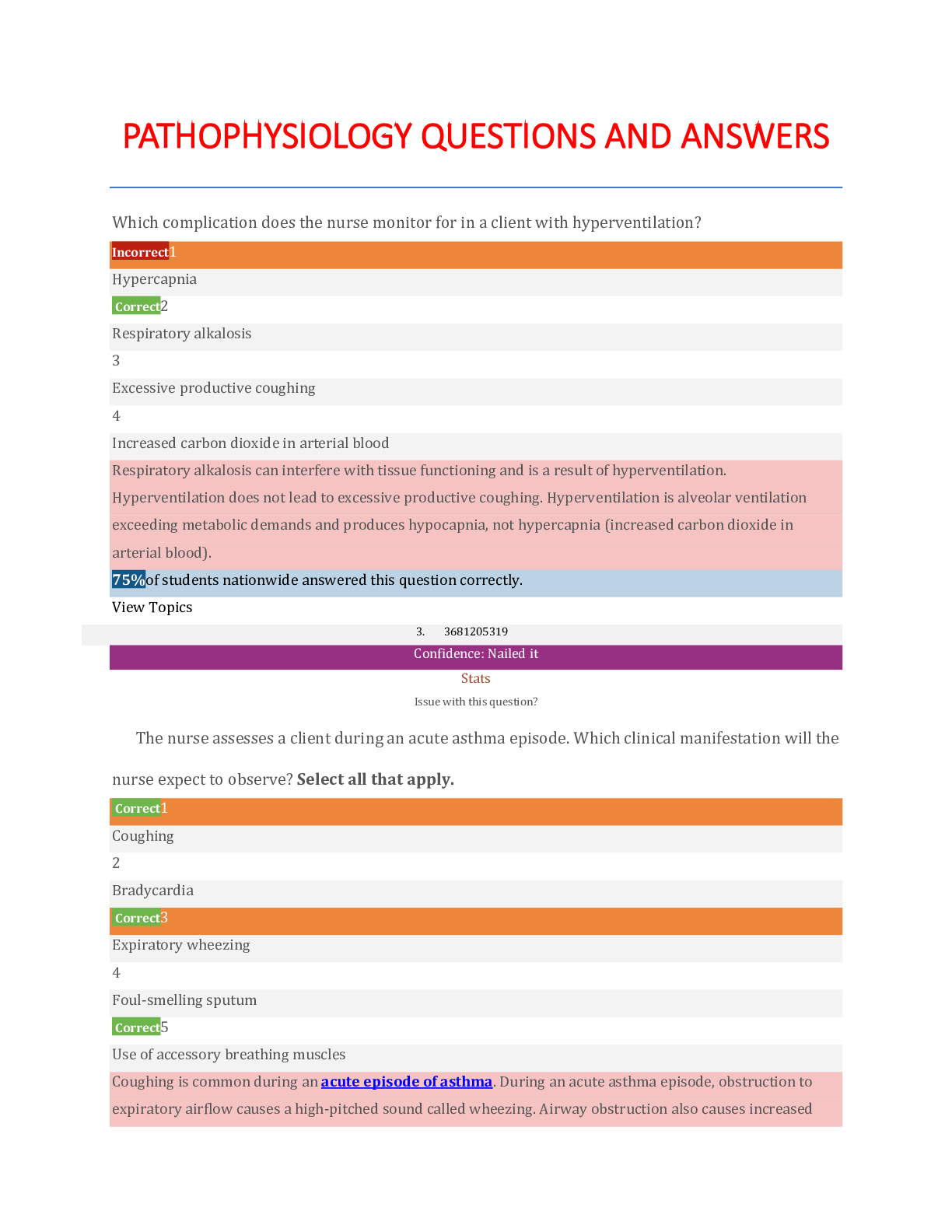
Buy this document to get the full access instantly
Instant Download Access after purchase
Buy NowInstant download
We Accept:

Reviews( 0 )
$5.00
Can't find what you want? Try our AI powered Search
Document information
Connected school, study & course
About the document
Uploaded On
Aug 10, 2020
Number of pages
31
Written in
All
Additional information
This document has been written for:
Uploaded
Aug 10, 2020
Downloads
0
Views
82


